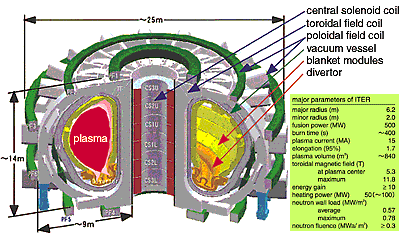 This picture, (189KB) |
||
|
| The first stage of ITER Engineering Design Activity (EDA) was completed in July 1998. However, the social and economical environment for proceeding to the next stage of construction activity was not satisfactory. A new technical guideline was agreed at a meeting of the member party representatives so that a future steady-state fusion reactor is targeted (without lost of the basic concept from the view point of future energy development), in a three years extension of the EDA and with an associated construction cost approximately half that of the previous ITER. The design of the newly agreed ITER is in progress based on the new technical guidelines discussed and concluded by the Board Members from the member parties. The purpose of the new engineering guideline is the first integral demonstration of significant DT burn and fusion reactor engineering: 1) To achieve extended burn in inductive operation with an energy gain (fusion power / input heating power) Q 2) To aim at demonstrating steady-state operation using non-inductive current drive with Q 3) To achieve extended burn with an average 14 MeV neutron wall load It is necessary for the design of ITER that the engineering design should result in a big cost reduction (the target is approximately 50% of the cost for the former design) based on the technical outcomes achieved by the engineering R&D and on the technologies expected to be achieved through the ongoing R&D. As for the concept of ITER apparatus, it was internationally agreed as a basic concept for the scaling down through a lot of discussions that, as Japan had proposed, high density plasma operation for both pulse and steady-state operation should be retained by keeping a high magnetic field and scaling down the apparatus. Based on the latest experimental data obtained from the existing large scale tokamak facilities, by balancing kinds of plasma parameters and by being consistent with tokamak components, design activities are proceeding. A schematic of ITER and its major parameters are shown in Fig. 2-14. It is expected that 400 second operation at Q=10 will certainly be achieved. Since ITER is designed by introducing a hybrid operation method combining inductive and non-inductive current drive, operation times longer than 2,000 seconds at Q Another important issue is the test of the reactor engineering equipment. Neutron flux from the burning plasma necessary for the test of the engineering equipment is expected to be more than 60% of the former ITER even though the fusion power is reduced to 1/3 of that of the former ITER. While the neutron fluence is ensured to be 1/3 of that of the former ITER, the ITER design is to be sufficiently flexible to achieve the same level of the neutron flux as in the former ITER with a small modification of the plasma shape and in-vessel components. |
| Reference G. Janeschitz et al., The Requirements of a Next Step Large Steady State Tokamak, Nucl. Fusion, 40(6), 1197 (2000). |
| Select a topic in left column |
|
Persistent Quest-Research Activities 2000 Copyright(c)Japan Atomic Energy Research Institute |